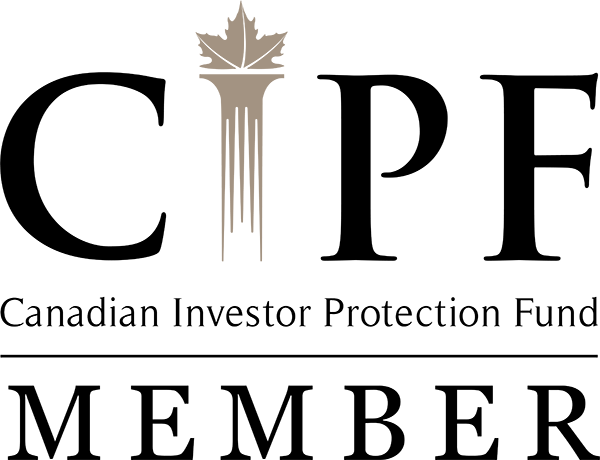THE QUARTERLY OPPORTUNITY UPDATE – TRANSCRIPT Q2 2022 Q2 2022
By: Chris Raper, CFP ®, CIM ®
Audio Version
Track #1: Introduction – The Skinny
Track #2: The Markets – We Are in Recession, Inflation Has Peaked For 2022 and Our Structural Deficit in Energy Remains
Track #3: Canada’s Energy Patch Continues to Shine – The Q2 Recap
Track #4: The Looming Supply Deficit in Metals and Key Takeaways
Track #5: Postscript I – Our Approach
Track #6: Postscript II – The Dividend Value Discipline™ Methodology
Track #1: Introduction – The Skinny
Hi, this is Chris Raper, Wealth Advisor & Portfolio Manager with the Private Client Group of Raymond James Ltd. & co-founder of Aspira Wealth. Welcome to The Quarterly Opportunity Update, which was recorded for you on Thursday, July 14, 2022. This recording is accompanied by a transcript complete with charts that provide evidence to the issues I will be speaking on – I believe you will get a lot more out of the audio by referencing the transcript.
You are listening to Track # 1: The Skinny, where I give you the high points on what we are going to cover today.
On Track # 2: The Markets – We Are in Recession, Inflation Has Peaked For 2022 and Our Structural Deficit in Energy Remains – Simply put, that’s how we see the world today. I will provide you with the key evidence that brings us to those conclusions and finish with the incredible opportunity for Canadian investors that we have before us as a result of our structural energy deficit.
On Track # 3: Canada’s Energy Patch Continues to Shine – The Q2 Recap – I will bring you up to date on where we landed performance wise on each of our seven in house investment strategies and bring to light the incredible rent cheque growth we have experienced thus far this year. That helps us keep our eye on the ball so to speak. As my son-in-law, Adam Wowchuk reminded me yesterday, it is hard for things to grow when you dig up the seeds you planted. What a fantastic analogy for owning companies as opposed to trading stocks!
On Track # 4: The Looming Supply Deficit in Metals and Key Takeaways – I will lay out our case on what we see as multi- year bull market coming within the industrial/metals/mining complex and you will clearly see the parallels with where we find our energy complex today. Then I will wrap it up with the key takeaways.
Track #5: Postscript I – Our Approach is for the benefit of prospective clients. It will give you some insight into the new client process through which we walk interested parties. To give you a brief insight, we start with you and your story - our approach is tailored to your “do, have, and legacy” ambitions. In short, we need to understand your aspirations before we can help you achieve them.
On Track #6: Postscript II is where I walk you through the methodology and return objectives of our core program, The Dividend Value Discipline™. If you have an interest in the specifics of our core investment process, you will probably get a lot out of it – if that’s not you, you may want to give it a pass.
In terms of legal requirements, there are three things to note:
- The opinions that are expressed on this recording are mine. They may differ from those of Raymond James Ltd.
- Raymond James Ltd. is a member of the Canadian Investor Protection Fund. That is a good thing. If you are interested in those details, please ask me or any one of our relationship managers the next time we speak.
- The transcript of this recording provides links to other Internet sites for the convenience of users. Raymond James Ltd. is not responsible for the availability or content of these external sites, nor does Raymond James Ltd. endorse, warrant or guarantee the products, services or information described or offered at these other Internet sites. Users cannot assume that the external sites will abide by the same Privacy Policy to which Raymond James Ltd. adheres.
I also want you to recognize that some of the things I am going to say today are going to be proven wrong. It is an inevitable part of this business. It is also important to recognize that you don’t have to be right all the time to do well. You just have to be more right than most or, conversely, less wrong than most.
Finally, regarding investment jargon, when I say I am bullish, it means I expect things to go up. When I say I am bearish, it means I expect things to go down. Likewise, north means up and south means down. When I speak about rent cheques, I am speaking about income, primarily dividends. You may hear me using the term “disruptor”, which is our moniker for those companies that are disrupting or re-inventing the way business is done in their particular market and are thereby able to grow at rates far faster than the rest of the economy. Think of Wal-Mart 20 years ago and Amazon today. You may also hear me use the term “aggregator”, which is our moniker for those companies that have a systemized approach to acquiring smaller competitors as a means to fuel their growth. That growth is the path to increasing dividends or, in our language, growing rent cheques. If you catch me using industry jargon beyond that, I invite you to call me out. Send an email to the office and the team will let me know, usually with considerable gusto!
That’s a wrap on the skinny, and off we go to Track #2.
Track # 2: We Are in Recession, Inflation Has peaked For 2022 and our Structural Deficit In Energy Remains
At the macro level, that is how we see the world today. I also want you to know that I have presented those claims in inverse order of importance. Let’s unpack the evidence.
We Are in Recession
Most listeners will know that our best leading indicators of the global economy are the price of copper and the price of semiconductors. The former speaks to what is happening in the manufacturing-based economies (products) whereas the latter speaks to the ingenuity-based economies (services).
When I spoke to you on the April 7/22 edition of this recording, the shiny red metal was trading at $4.75, and yesterday, it pegged in at $3.32. Clearly, the demand for copper has fallen off a cliff, and it really does not matter whether it is due to higher interest rates, China’s Covid lockdowns or supply chain disruptions, Dr. Copper is screaming that the manufacturing economies are slowing. Not only is that true in south east Asia but think about what is going within the industrial powerhouse we know as Germany - people are being told they will have to endure cold showers and rolling blackouts. How do you keep the lights on at a manufacturing plant with that kind of scenario?
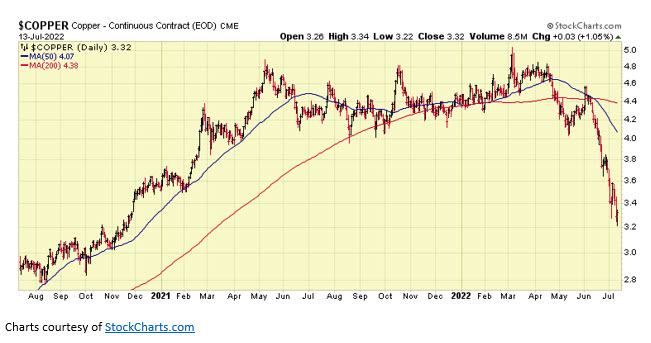
Turning to the Philadelphia Semiconductor Index ($SOX), recall on the last recording we posited, “we see the price of semiconductor stocks reflecting a pattern of lower highs and lower lows; ergo, it is suggesting slower growth ahead for our service-based economies and begs the question, could it turn negative? Put another way, are we heading for a recession or just a slowdown?” As I speak, the $SOX is down some 20% since that statement and ~ 35% on a YTD basis, there is no evidence to suggest anything but recession.
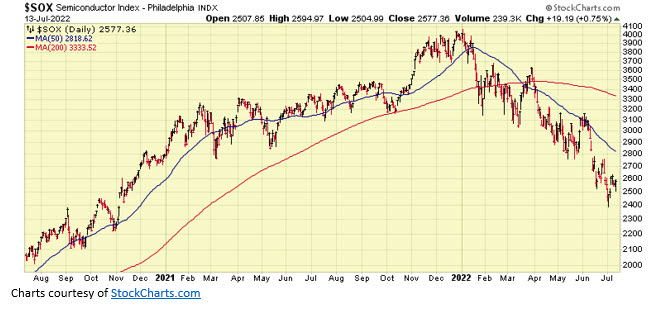
If you need a little more evidence that things are slowing in the world of human ingenuity, consider that computer programmers in Silicon Valley have gone from, “I am not coming into the office ever again” and $500K compensation packages to looking for a job. Even the behemoths are reducing headcounts - companies like Facebook, Google and Shopify. The trickle-down effect is well underway.
Recall that both copper and the $SOX are leading indicators, whereas a recession is defined as two back-to-back quarters of negative growth. In other words, you have to experience the negative growth before you can call a recession.
Let’s remember that market bottoms and the bottoms of recessions never coincide. The stock market is a forward-looking animal, and thus, by the time the all clear signal happens, the stock market will have moved substantially higher. Thus Peter Lynch’s old adage, there is much more money lost preparing for the recession than during the recession.
Inflation Has Peaked for 2022
First up, the rate of inflation is a lagging indicator, so notwithstanding yesterday’s, the headline numbers out of the US where annualized inflation notched 9.1%, the highest since 1981, that is not the number to watch. It is the leading indicators that matter. On that front, directionally speaking, things are pretty much the same as we stated in our June 13th, Timely Market Dispatch:
- The growth in money supply is falling like a stone - witness Canada’s 1% increase in the Bank of Canada rate yesterday. Global central banks are draining the proverbial punch bowl.
- Higher interest rates continue to bite – the latest data from Manheim shows used vehicles prices down ~7% on a YTD basis to end of May, and every real estate report I read screams the market is slowing. According to Redfin, 15% of pending home sales in the US got cancelled in June, the highest rate since the Covid-induced lockdowns since April 2020 – oil, ergo gasoline, is well off its highs, as is natural gas. Ditto for corn, wheat and soybeans. To wit, from their respective 2022 peaks:
- oil is down 27%
- natural gas - down 31%
- corn - down 27%
- wheat - down 40%
- soybeans - down 16%
- The economy continues to slam on the brakes - Citigroup’s Economic Surprise Index Citigroup Economic Surprise index is currently at ~ negative 60 after reaching ~ negative 80 level in late June 2022.
Our take is that inflation has peaked for 2022 – when the economy starts growing again, we expect inflation to reignite, and it will be a persistent challenge for years to come.
We Remain Structurally Deficient in Energy
If there is a back page story that deserves to be front page news, this is it – globally speaking, our structural vulnerability to the energy shortage is now acute, and investors and politicians are starting the hard process of changing their view and thus their strategy - the evidence of the pending shortages is just too overwhelming. The converts will not come easily, but they will come because the everyday person on the street, the voters, are all too tired of the failed policies that have us paying +$2.00 per litre gasoline and seeing those high energy prices filter into every aspect of our lives.
How did we get here? In short, energy producers have been starved for capital – our green ambitions, the Covid-induced demand destruction and the seemingly infinite money to be made in technology stocks all played their part in curtailing production. In short, nobody wanted to be seen as investing in energy companies and thus they had no money to re-invest. The good news is that the companies became incredibly cheap as that phenomena played out.
By now, you may be asking yourself, hold on Chris, you say we are now in recession, should you not be backing away from energy and other commodity-related investments? Over the last 10+ years, my answer would be a decisive yes, but given that the shortage of energy is so acute and the prices of the energy-producing companies so inexpensive relative to their cash flow, selling those companies thinking we can catch the bottom of the recession is akin to picking up nickels in front of bulldozers. At the company by company level, our Canadian oil and gas producers have skipped their normal past cycle behaviour of “pump baby pump” and focused their incredible cash flows on paying down debt and returning cash to shareholders. Thus their balance sheets are incredibly strong, and most of the energy-related companies we own could theoretically pay back all their debt and buy back all their stock within 3 years at $100 oil…and we remain structurally deficient in oil … I mean, what would you have me do?
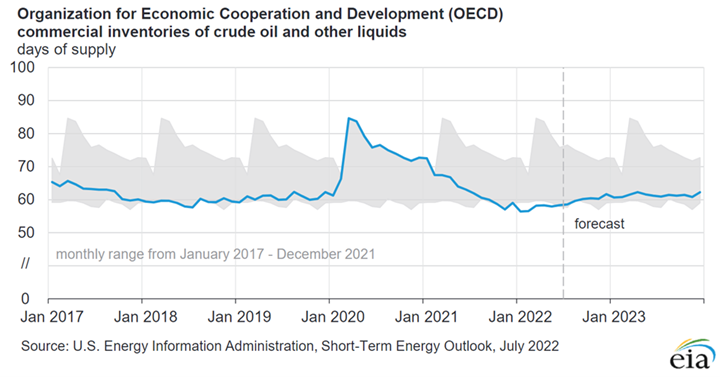
At the close of business yesterday, the only sector within the S&P 500 with a positive YTD return has been energy, up 26% despite the recent pummeling. The worst performing sectors have been Consumer discretionary (read Amazon) at -30%, communications (read Google and Facebook) -29% and technology (read Apple and Microsoft) at -25%. I believe the sector-by-sector performance on a year-to-date basis is illustrative of where money is moving from and where money is moving to. Let’s be like Gretzky – skate to where the puck is going to be.
S&P 500 Sector Performance on a YTD basis as of July 13, 2022
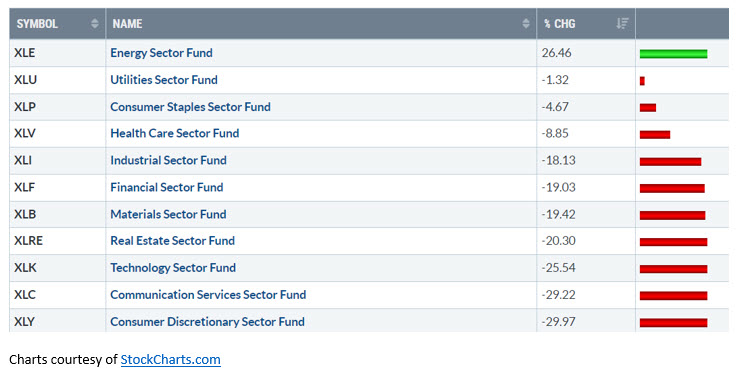
Summing it all up - we believe we are in a global recession now, so what are we to do? First, recognize that slowdowns and recessions are part of the program, as are down markets. It is the price we pay for equity type returns.
There is lots of evidence to suggest we have hit the peak inflation rate for 2022 – when we get to the other side of the recession, we expect it to be a persistent problem for years to come.
The supply crunch in all things energy is very real, and there are no quick fixes. We can protect ourselves from inflation by owning the companies that produce the goods that are inflating us most, i.e., energy. The good news is that they continue to represent extreme value.
With that, we are off to Track #3.
Track #3: Canada’s Energy Patch Continues to Shine – the q2 Recap
You do not need me to tell you that the 2nd quarter of 2022 has been anything but smooth sailing. Given the outsized year we had in 2021, we really should not be surprised. Again, slowdowns and recessions are part of the program, as are down markets. It is the price we pay for equity type returns.
The YTD Q2 numbers for our strategies are as follows:

*Please be reminded that the performance numbers are only applicable to those accounts we manage within the Raymond James Ltd. (Canada) platform. Our cross border clients who have accounts domiciled at Raymond James USA Ltd. will have different results, in large part due to currency swings.
Please note those figures do not include the returns from the non-discretionary side of your accounts. For most of our clients, that is the ultra-conservative side, i.e., the guaranteed investment certificates (GICs) and high interest savings accounts (HISA). Obviously, the latter will have the effect of reducing the impact of negative short-term returns in a down market and the converse is also true. Our objective is to make sure we never have to sell stocks in a down market to meet your cash flow requirements.
As you know, the timing of cash flows and our buy-only approach for new money translates to considerable variability in actual client experience. For your awareness, your Raymond James Ltd, June 30, 2022, statements are now up on your client login site. If you are not using that site, please reach out to us so we can get you up and running. We will kill less trees, it has 24/7 access and is far more secure than email.
While the news headlines are laden with FEAR – false expectations appearing real – and thus the prices of our holdings in aggregate are down, let’s not lose sight of the good things that are happening at the company-by-company level. To wit, we have notched rent cheque (dividend) increases in 20 different companies we own during the second quarter of 2022, and the biggest bumps are coming from Canada’s energy patch. Our top 5 bumps are:
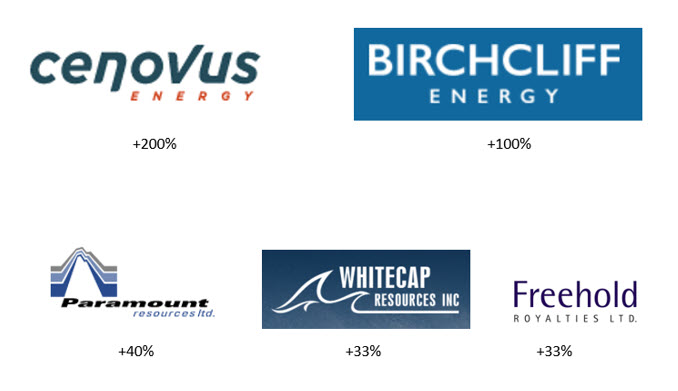
To close out this track, I want to speak to the current market malaise. Investor sentiment and consumer confidence are just dismal - is it just coincidence that historically speaking, such conditions have been amongst the very best times to add money to equities? For those of you tracking with me using the transcript and corresponding charts, the evidence is pretty clear.
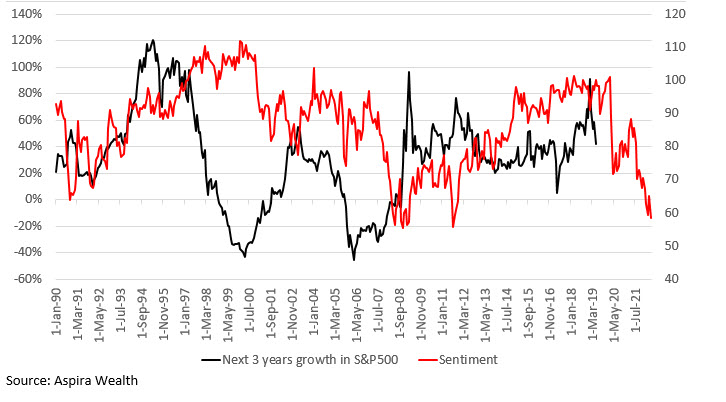
That concludes Track #3.
Track #4: The looming Supply deficit in metals
As we see it, the industrial metals complex is setting up for years of outperformance. Here’s why - everything I have shared with you about how we got into such a supply crunch in oil and gas is true for the world’s miners. What is less appreciated is that our global green energy agenda is pushing the demand for metals and minerals in ways we have never seen before. Consider the fact that an all-electric vehicle has six times the metal/mineral content as its gasoline-powered sibling. Every EV produced means more demand for copper, cobalt, nickel, lithium and a host of rare earth
metals. Yes, we have to tear up the earth’s crust to get those things, which might lead us to ask, “Do all those upstream environmental costs get counted?” Be that as it may, a lot of the known deposits are in places like Latin America and Africa, which are areas where China has been an active investor with its Belt & Road initiative (investing in roads and ports) for years. That puts China in a powerful position for years to come, but the West is not going to give up its economic dominance easily. Canada and Australia have tremendous resources, and just like the current Russia/Ukraine crisis has changed the European opposition to nuclear, attitudes in the West regarding mining will change as well.
Unlike oil, the taps for copper and the like cannot be turned on and off quickly. It takes a minimum of 10 years to develop a mine after you have proven out the resource. In the last ten years, we have spent little to nothing on discovering new resources. Notwithstanding the current collapse in copper prices, we will be exhausting our mines versus forecast demand as early as late 2023. Industry watcher Wood Mackenzie unpacks this story in their missive of June 30 last Why miners won’t invest in the metals supercycle, and you will clearly see the parallels of our energy story. It just takes longer to play out and thus the coming opportunity. On a side note, I have experienced this movie before – my single best stock pick of my career, thus far of course, was a copper producer called Aur Resources which was a multi-bagger in the early 2000s.
With that let’s move to the recap:
Track # 1 the key takeaway is that some of what I told you is going to turn out to be wrong. It is just part of the territory.
Track # 2, our leading indicators are telling us we are now in a global recession – how long and how deep are unknowable, but let’s recognize back-to-back deep recessions are super rare. Recall oil went to zero for a brief time in early 2000, and if that does not qualify as a deep recession, I don’t know what does. We have likely marched past the peak inflation number for this cycle. Wherever we look, we see prices moderating and the economy slowing. Last and by far most important, our structural deficits in global energy, coupled with the current economic slowdown/market collapse, is presenting us with incredible value propositions, specifically within the Canadian energy complex. We need to skate to where the puck is going.
Track # 3, despite the short-term negative performance numbers, when we look at our investments on a company-by-company basis, the rent cheques are growing, and they are growing incredibly well in the Canadian energy space.
Track # 4, the takeaway is that we will see the current energy story play out in metals. It will just be in slow motion, because that is the nature of developing mines. This is good news for long-term investors, and a significant opportunity that we intend to exploit.
That brings us to a close for this edition of The Quarterly Opportunity Update. A reminder, if you are being introduced to us by way of this recording, then Tracks #5 and #6 are for you. Thank you for taking the time to listen. If you have people in your life who you think might benefit from these missives, please forward them as you see fit. Alternatively, they can sign up through our website, where all that is required is a first name and email address. Alternatively, they can book some time at Book Appointments. This is Chris Raper, cofounder of Aspira Wealth, wishing you and your loved ones all the best - good day and may God bless from Victoria B.C. on Thursday, July 14, 2022.
Track #5: Postscript I – Our Approach
While this recording has been focused on investments that is not where we start with new relationships. We start with your story, and we revisit it often. Knowing where you came from and what you want the future to look like – your do, have, and legacy ambitions – is the foundation for building a solid client/wealth advisory relationship. Our first order of business is to listen, seek clarity and then document your ambitions for the future – we call it, Your Story, Revisited.
From there, we complete a 360⁰ review of all relevant investment, tax/estate and insurance documents in an effort to identify gaps/risks to the future you envision. When we identify holes, we have a discussion about how we might fill those holes.
Then and only then do we get into a discussion on the investment allocation. We will address your liquidity, income and growth requirements/desires and introduce you to tax smart investment strategies to meet those needs.
After we invest, it is a matter of manage and measure – we report regularly, and when life throws you the inevitable curve ball or your priorities change, it is back to revisiting your story.
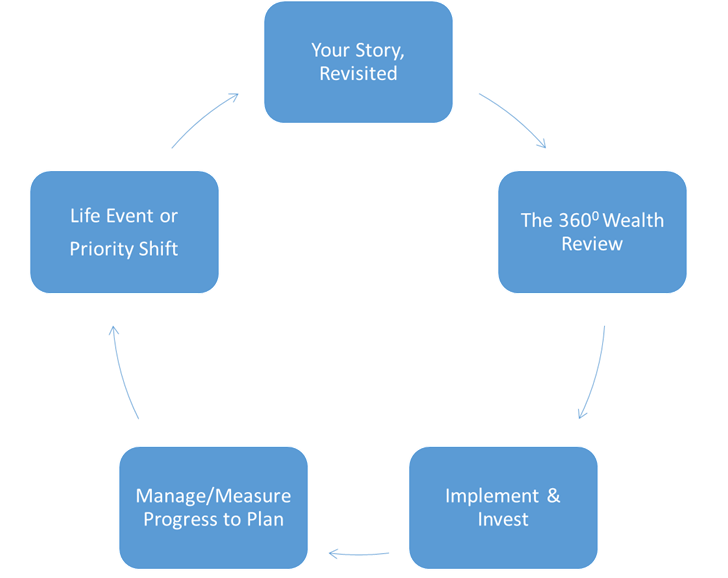
In summary, we learn about you, your family, your finances and what your ideal future looks like – the things you want to do, the things you want to have and the legacy you want to leave. We identify the structural risks and how we see mitigating them. We paint a go forward picture with a worst case analysis of the costs involved.
Generally speaking, we are looking to establish relationships with new clients that have north of $1 million in investable assets, but please understand that we are a lot more interested in where you are going than where you are. If you have a credible plan to get to that number, say within a three- to five-year period, we are very interested in meeting with you.
So if that process sounds engaging, I invite you to call and book some time. If you’d like further information, including access to our quarterly communication pieces, you can check us out online at www.aspirawealth.com and send us an email from there.
Track #6: Postscript II – The Dividend Value Discipline™ Methodology
The first thing I want to share with you is that The Dividend Value Discipline™ is our core mandate – essentially, all of our clients have a slice of their portfolio allocated to it. For your awareness, we currently have several strategies that we manage in house, in addition to a short list of 3rd party money managers. Structurally, most clients have three buckets of money with us – a safe money bucket, an income bucket and a growth bucket. The Dividend Value Discipline™ straddles the latter two, and depending on your needs, we augment it with other strategies. The program continues to be a large slice of our client assets under management.
The process is discretionary, meaning, we make all of the buy and sell decisions and report to you after the fact.
Our objectives for the program are:
- Income every month – that can be paid out or reinvested;
- An acquisition process where we buy only those securities that become attractive on a “go forward” basis;
- Absolute returns of 8%+ over any investment cycle, which we would describe as peak to peak or trough to trough. If you are looking for a timeframe in terms of years, think 5+ years, but please understand investment cycles have a wide range of timeframes.
The program operates with three key elements, and I will walk you through them using the illustration of a three-legged stool.
The First Leg Is Dividends
With few exceptions, every security that we buy must provide some form of income. We do that because income makes portfolios inherently less volatile, i.e., less chance of loss. The analogy I like to use is that of an apartment block versus a piece of raw land – it is a lot easier to hold on to an apartment block in a tough real estate environment when you are getting a rent cheque every month. Income drives stability and absolute returns.
The Second Leg Is Value
Our research function is in house. When we launched the program back in September 2002, we were one of the first private client teams in the industry to have a dedicated analyst among our staff, and we add additional resources every year. We spend an inordinate amount of time studying the corporate culture of potential investee companies. If you are interested in what great corporate culture looks like, I encourage you to read Good to Great by Jim Collins – that is the yardstick we use to measure potential investments. Another yardstick is the importance of wide economic moats – the things that make a company tough to compete against. We want to own companies that the end client can’t live without – great examples might be Microsoft or Intuit, both long-term holdings of ours.
We believe that the focus on great corporate culture and wide economic moats gives us an edge, and while I can’t prove it you, I can certainly give you lots of anecdotal evidence to support that thesis. The more recent development in our strategy has been tackling the growth problem. History buffs will note that when we started the program in 2002, we had 5-year GICs yielding roughly 5% and much better economic growth; whereas today, the 8% is tougher to come by.
Accordingly, we spent late 2015 and 2016 tackling the growth problem. We needed to find companies that were growing far faster than the economy. As you would expect, we started within the normal confines of “has to pay a rent cheque, score well on the corporate culture front and have some sort of strategic advantage (moat) that makes the company difficult to compete with”. We then focused on those companies that have demonstrated their ability to grow their earnings/dividends at double-digit rates as a primary indicator of income growth and capital gain potential. As we searched, we found that most such companies fell into one of two themes. They tended to be disrupting the existing marketplace (think Wal-Mart 20 years ago or Amazon today) with a better way of doing things, and/or they tended to be aggregating their way to growth by buying smaller tuck-in acquisitions, much like Constellation Software Inc.
The Third Leg Is Discipline
Here, I refer to the buy/sell decisions. On the buy side, I would sum it up as “do your homework, be ready, be patient”. Over the years, our absolute best buys have been when we have done our homework on the company, perhaps months before, and then some untoward event happens that gives you opportunity to buy in size. The Euro debt crisis in 2011 is a great example that enabled us to buy Nike at a terrific price because we were ready, and we had conviction. More recently, I would put the world’s #3 French fry maker, Lamb Weston, in that category.
Sell decisions are getting increasingly tougher because the quality of our companies just keeps going up, and with their rent cheques (dividends) growing at double-digit rates, our history tells us more often than not that we are better off holding than chasing shiny baubles. That said, new competitors with disruptive technologies can wreak havoc on a company’s growth prospects – back to the Amazon/Wal-Mart example. Transition periods of senior management teams can be risky, especially when there is a no hire-from-within bias. Then there are times when the price of a stock just gets so far in front of its growth prospects that the only reasonable thing to do is sell. As Buffett likes to say, “You pay a high price for a rosy consensus”. When things are universally rosy, we try to be sellers, not buyers.
Perhaps the most important part of the buy/sell discipline is the way we operate the program for new entrants – we call it “The Buys Only Mandate”. Unlike most of our competition, we only buy those securities that become attractively priced on a go-forward basis; meaning, if you start today and your brother starts three months from now, your portfolios are going to be different in the short term, and more closely aligned the longer you are in the program together. As rational as that might seem, most people do the exact opposite. Every time you buy a mutual fund, you buy a pro-rata share of an existing portfolio – by definition, you got the buys, the holds and the near sells. To us, that is not rational. Who buys 100+ companies in a single day? Were they all great value propositions? You should also be aware that most third party money management programs work exactly the same way – they buy the basket. The buys only mandate was designed to protect your hard earned money.
Chris Raper, CIM, CFP ®
Co-Founder, Senior Wealth Advisor, Cross Border Specialist
t 250.405.2434 | toll free 1.877.655.5580 | web www.aspirawealth.com
The information contained in this report was obtained from sources believed to be reliable, however, we cannot represent that it is accurate or complete and it should not be considered personal tax advice. This report is provided as a general source of information and should not be considered personal investment advice or solicitation to buy or sell securities. The views expressed are those of the author and not necessarily those of Raymond James. We are not tax advisors and we recommend that clients seek independent advice from a professional advisor on tax-related matters. This provides links to other Internet sites for the convenience of users. Raymond James Ltd. is not responsible for the availability or content of these external sites, nor does Raymond James Ltd endorse, warrant or guarantee the products, services or information described or offered at these other Internet sites. Users cannot assume that the external sites will abide by the same Privacy Policy which Raymond James Ltd adheres to. Raymond James Ltd., Member—Canadian Investor Protection Fund. Raymond James (USA) Ltd. (RJLU) advisors may only conduct business with residents of the states and/or jurisdictions for which they are properly registered. Raymond James (USA) Ltd. is a member of FINRA/SIPC.




